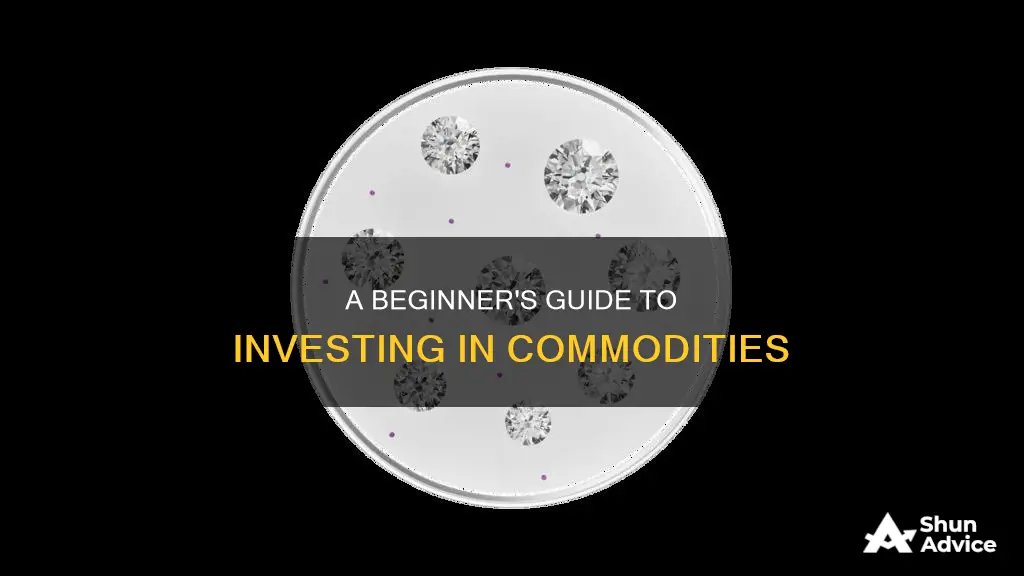
Investing in commodities can be a risky but potentially rewarding endeavour. Commodities are raw materials that are either consumed directly, such as food, or used as building blocks to create other products. They are traded daily on markets worldwide and are an important part of the global economy. Investing in commodities can be a way to diversify one's portfolio, as their performance often diverges from the stock and bond markets. However, commodity prices can be extremely volatile due to various factors such as supply and demand, world events, and economic conditions. Investors can consider physical ownership, mutual funds, or alternative investments such as hedge funds and futures contracts. It is essential to understand the risks and work with a financial professional before investing in commodities.
| Characteristics | Values |
|---|---|
| Definition of commodities | Basic goods used in commerce that are interchangeable with other goods of the same type |
| Examples of commodities | Crude oil, soybeans, gold, corn, metals, natural gas, sugar, wheat, cotton, pork, cattle, aluminium, copper |
| Types of investment | Physical ownership, mutual funds, alternative investments |
| Alternative investments | Hedge funds or private investments |
| Risks | Market price fluctuations, regulatory changes, interest rate changes, credit risk, economic changes, political risks, lack of income, high volatility, unpredictable returns |
| Benefits | Diversification of portfolio, strong performance in periods of high inflation, protection against losses |
What You'll Learn

Commodities are raw materials
Commodities are the raw materials that feed and power the global economy. They include crude oil, soybeans, gold, and more. They are also an actively traded class of investments that many investors have in their portfolios.
Commodities can be traded in several ways. One is to purchase varying amounts of physical raw commodities, such as precious metal bullion. Investors can also invest through the use of futures contracts or exchange-traded products (ETPs) that directly track a specific commodity index.
Commodities prices can be extremely volatile and unpredictable. They can be influenced by world events, import controls, worldwide competition, government regulations, and economic conditions. For example, wheat prices shot up in 2022 due to the Russian invasion of Ukraine. This price movement impacted the futures and options market around wheat.

Investing in commodities is risky
Commodities are highly susceptible to global events, economic conditions, and supply and demand fluctuations, resulting in unpredictable price movements. For example, wheat prices surged in 2022 due to the Russian invasion of Ukraine, impacting the futures and options markets. Similarly, oil and gas markets were affected by Russia's role as a major supplier. These external factors, such as regional conflicts, climate risks, and political instability, can significantly influence the supply and demand of commodities, making investments risky.
The lack of dividends or interest payments in commodities adds to the investment complexity. Returns solely depend on buying low and selling high, requiring accurate predictions of price movements. This high volatility in commodities means that investors can make substantial profits or losses. Small traders, in particular, face significant risks due to the high degree of leverage in commodity futures, where a small margin can control a large amount of the commodity.
Additionally, regulatory changes, interest rate fluctuations, credit risks, and economic shifts can further impact commodity investments. These factors contribute to the overall riskiness of investing in commodities, making it crucial for investors to thoroughly understand the market and their risk tolerance before venturing into this asset class.
S&P 500: Why Aren't You Investing?
You may want to see also

Diversifying your portfolio
Commodities are raw materials that are either consumed directly, such as food, or used as building blocks to create other products. They are an important part of our everyday lives and can be a good way to diversify your portfolio.
Commodities are typically interchangeable with other goods of the same type. They are usually mined, pumped out of the ground, or grown on farms. Examples include crude oil, natural gas, soybeans, wheat, metals, and sugar.
Commodities can be a good way to diversify your portfolio because they tend to provide returns that differ from other stocks and bonds. A portfolio with assets that don't move in lockstep can help you better manage market volatility. For example, commodities have shown strong performance in periods of high inflation, which can erode the value of stocks and bonds.
However, it's important to note that investing in commodities can be risky due to unpredictable returns and high volatility. Commodity prices can fluctuate due to factors such as supply and demand, exchange rates, inflation, and the overall health of the economy. There are also external risks that are out of the investor's control, such as regional conflicts, climate risks, regulatory changes, and political risks.
There are several ways to invest in commodities, including:
- Purchasing physical raw commodities, such as gold or silver bullion.
- Investing in producers of commodities, such as through ETFs, which can benefit from both the cash flow of the company and the rising price of the commodity.
- Using futures contracts, which allow you to set a price now and deliver and receive payment at a future date.
- Exchange-traded products (ETPs) that directly track a specific commodity index.
- Hedge funds or private investments specializing in commodities, although these carry a high degree of risk and volatility.
Fees, Funds and You: The Cost of Investing
You may want to see also

Commodity prices fluctuate
Commodities are raw materials that are either consumed directly, such as food, or used as building blocks to create other products. They are basic goods used in commerce that are interchangeable with other goods of the same type. Commodities are an actively traded class of investments that many investors have in their portfolios. They are traded every day on markets around the world and are important parts of our everyday lives.
Commodity prices can be extremely volatile, and the commodities industry can be significantly impacted by world events, import controls, worldwide competition, government regulations, and economic conditions, all of which can affect commodity prices. For example, wheat prices shot up in 2022 due to the Russian invasion of Ukraine, and this price movement impacted the futures and options market around wheat. There were similar impacts on the oil and gas markets due to Russia's position as a major supplier.
Commodity prices often follow inflation, which makes them appealing to investors looking to diversify their portfolios. Inflation can erode the value of stocks and bonds but can mean higher prices for commodities. However, commodities can be much more volatile than other types of investments, and there is a chance your investment could lose value.
There are several ways to invest in commodities. One is to purchase varying amounts of physical raw commodities, such as precious metal bullion. Investors can also invest through the use of futures contracts or exchange-traded products (ETPs) that directly track a specific commodity index.
Will Bernstein's Timeless Investing Wisdom
You may want to see also

Commodity futures and options
A futures contract is an agreement to buy or sell a predetermined amount of a commodity at a specific price and date in the future. They are often used to hedge or protect an investment position or to bet on the directional move of the underlying asset. For example, a company may buy wheat futures to secure prices, while an airline might purchase energy futures.
Commodity futures can be contrasted with the spot commodities market, where the commodity is traded at its current price and involves taking immediate delivery of the physical good. Futures are usually traded by commercial enterprises that depend on commodities for their business activities, but they are also traded by sophisticated investors looking to profit from price changes.
Futures can be very complex and volatile, and they are considered a risky investment strategy due to the significant amount of leverage involved. A small move in the price of a commodity can result in large gains or losses compared to the initial margin. This high degree of leverage can amplify gains and losses, and it is not uncommon for a broker to initiate a margin call, demanding additional funds to shore up the account.
Options are similar to futures in that they are also financial derivatives, but they differ in that options give the holder the right, but not the obligation, to buy or sell the underlying asset. In contrast, futures contracts are obligations to buy or sell, and failure to close an existing position could result in the investor taking delivery of a large number of unwanted commodities.
Securities Investment 101: Navigating the Buying Process
You may want to see also
Frequently asked questions
Commodities are raw materials that are either consumed directly, such as food, or used as building blocks to create other products. They are basic goods used in commerce that are interchangeable with other goods of the same type. Examples include gold, oil, wheat, and aluminium.
Investing in commodities can be risky due to unpredictable returns. Commodity prices can be extremely volatile and the industry can be significantly affected by world events, import controls, worldwide competition, government regulations, and economic conditions. There is a chance your investment could lose value.
There are several ways to invest in commodities. One way is to purchase varying amounts of physical raw commodities, such as precious metal bullion. Investors can also invest through the use of futures contracts, exchange-traded funds (ETFs), or exchange-traded products (ETPs) that directly track a specific commodity index.







